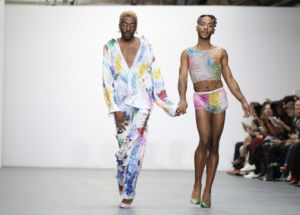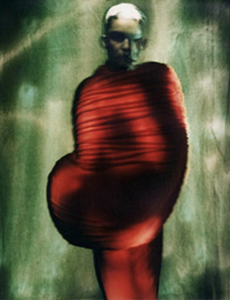Moschino advertising campaign, spring/summer 1990, drawing Franco Moschino.
I first started off by looking at this advertising poster made by the brand Moschino due to the powerful message that it possesses. I think that the juxtaposition between the monochrome, in contrast with the bright red, connoting passion and danger, works effectively in conveying Moschino’s anti-capitalism meaning. Franco Moschino’s objective behind this campaign in the 90s was to expose the constrictions made by high-end fashion institutions and encourage the ‘people’ to experiment freely with what fashion means to them. It shows how much power mainstream fashion institutions can have within the industry. I think however that this is a very ironic statement made by such a large fashion house who is known for leading the way within high end fashion, which before the 90s, followed many of the same ideologies as other large fashion houses that this poster could be referring to.
 Ashish, Spring/Summer 2016 Catwalk show.
Ashish, Spring/Summer 2016 Catwalk show.
From focusing on this topic, I thought that I would look into what boundaries are being tested to date within the fashion industry. One fashion brand I found of which has recently caught media attention is Ashish, who made its audience question gender fluidity back in 2016.
Above is one image that I found from their catwalk show which shows two male models, walking hand in hand down the runway in heels and wearing ‘feminine’ outfits. This gender fluid approach challenges the traditional ideologies presented to us about the fashion industry as a whole. I think that this approach allows the designer to be more playful within their designs, something in which I want to take away when thinking about who my own designs are for.
Rei Kawakubo for Comme des Garcons.
One exhibition that is relevant to my two previous research finds is the Iris and B.Gerald Canton Exhibition at the Met. The exhibition focuses on the work of Rei Kawakubo and Comme des Garcons which features 120 womenswear designs which blur the lines between what is wearable fashion, pushing boundaries similarly to how Ashish uses gender fluidity to push their design ideologies further.
Frisa, Maria Luisa (2004) Excess, Milano: Edizioni Charta.
HuffPost UK (2015), Ashish Bring Gender Fluidity To The LFW Catwalk. Available from:http://www.huffingtonpost.co.uk/2015/09/22/london-fashion-week-ashish-male-models_n_8177612.html [Accessed 1 November].
Rei Kawakubo for Comme des Garcons (founded 1969), Body Meets Dress – Dress Meets Body, Spring/Summer, The Metropolitan Museum of Art.


